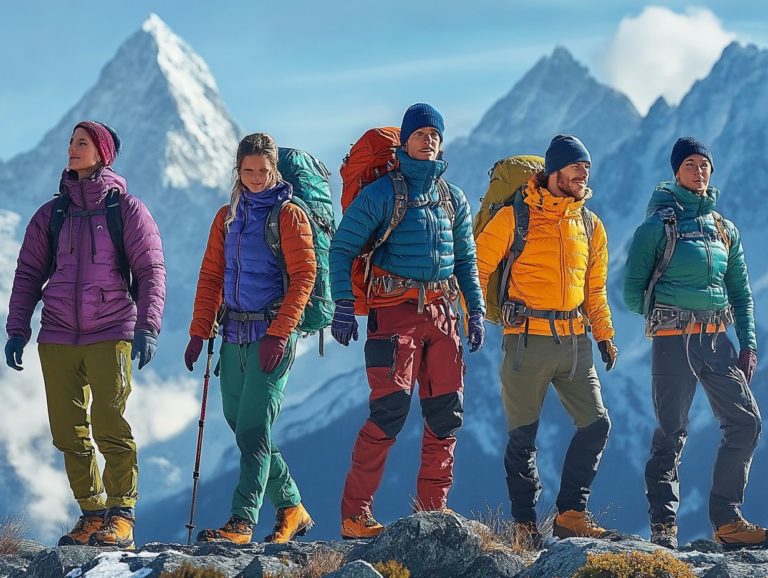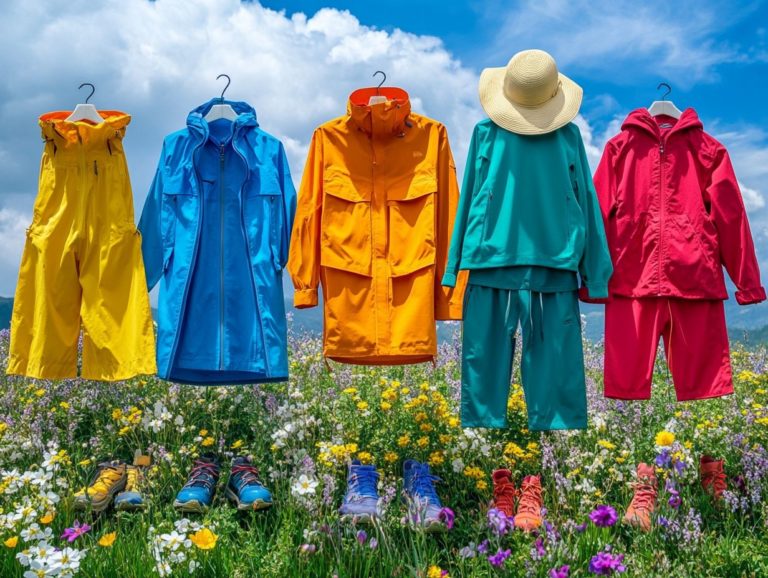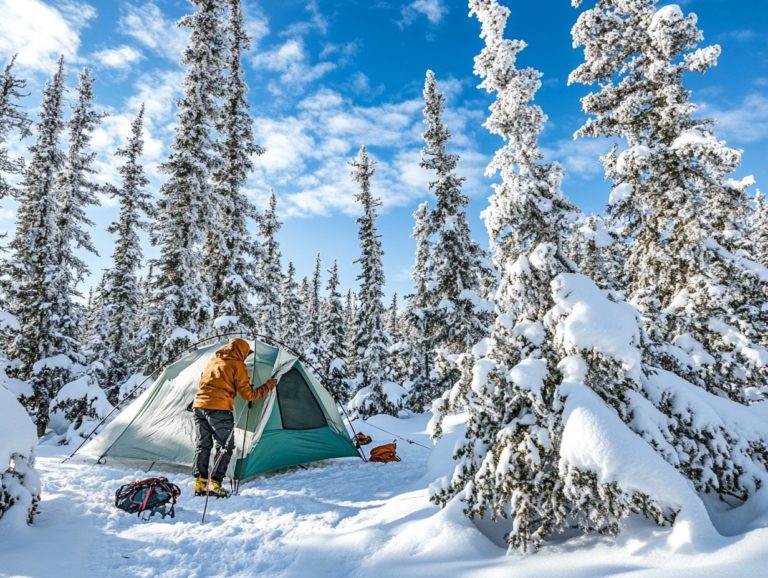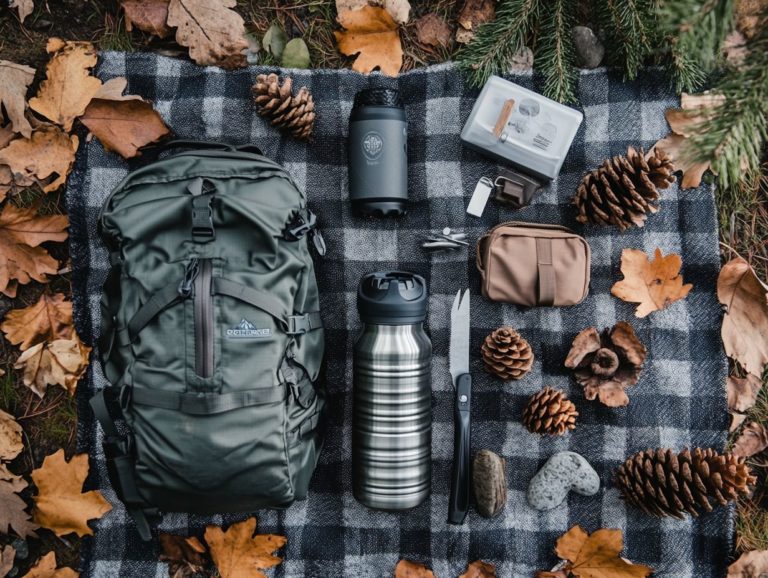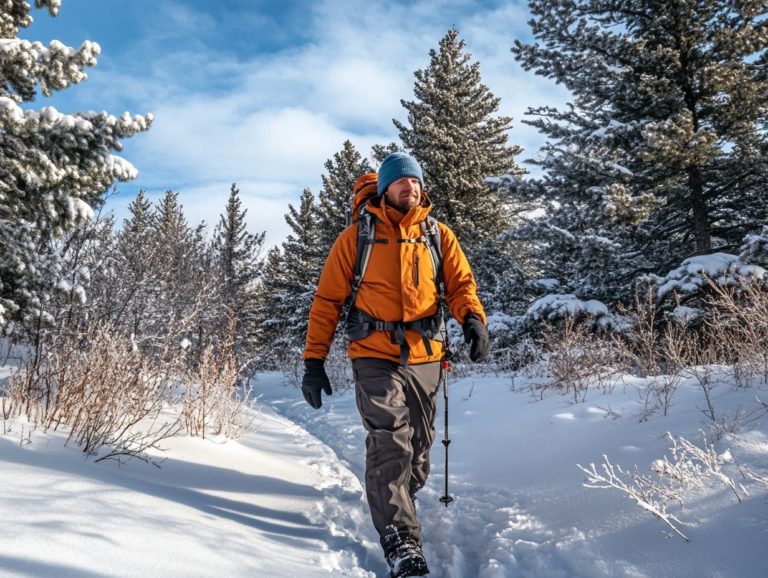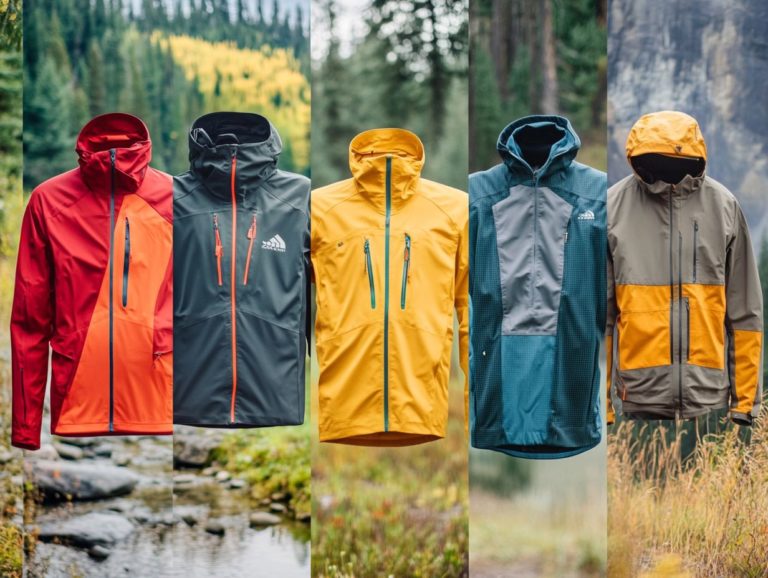Tips for Staying Dry in Outdoor Clothing
Staying dry in the great outdoors is essential. It ensures your comfort and safety. Hiking in unpredictable weather or engaging in water sports can lead to wet clothing, causing discomfort and health risks.
This article explores the significance of remaining dry, common culprits behind wet clothing, and how to select the right outdoor gear. You will find maintenance tips that are crucial for your gear, additional strategies, and emergency preparedness advice to ensure you’re equipped for any weather situation.
Get ready for your next adventure with confidence! You ll love how staying dry enhances your outdoor experience.
Contents
- Key Takeaways:
- The Importance of Staying Dry in Outdoor Clothing
- Common Causes of Wet Clothing
- Choosing the Right Outdoor Clothing
- Proper Care and Maintenance for Outdoor Clothing
- Additional Strategies for Staying Dry
- Get Ready for Wet Weather
- Frequently Asked Questions
- What are some tips for staying dry in outdoor clothing?
- How can I ensure my feet stay dry while wearing outdoor clothing?
- Are there any specific clothing items I should bring to stay dry in outdoor conditions?
- Is there anything I can do to maintain the waterproofing of my outdoor clothing?
- What should I do if I accidentally get my outdoor clothing wet?
- Want to Stay Dry in Outdoor Clothing? Check These Tips!
Key Takeaways:
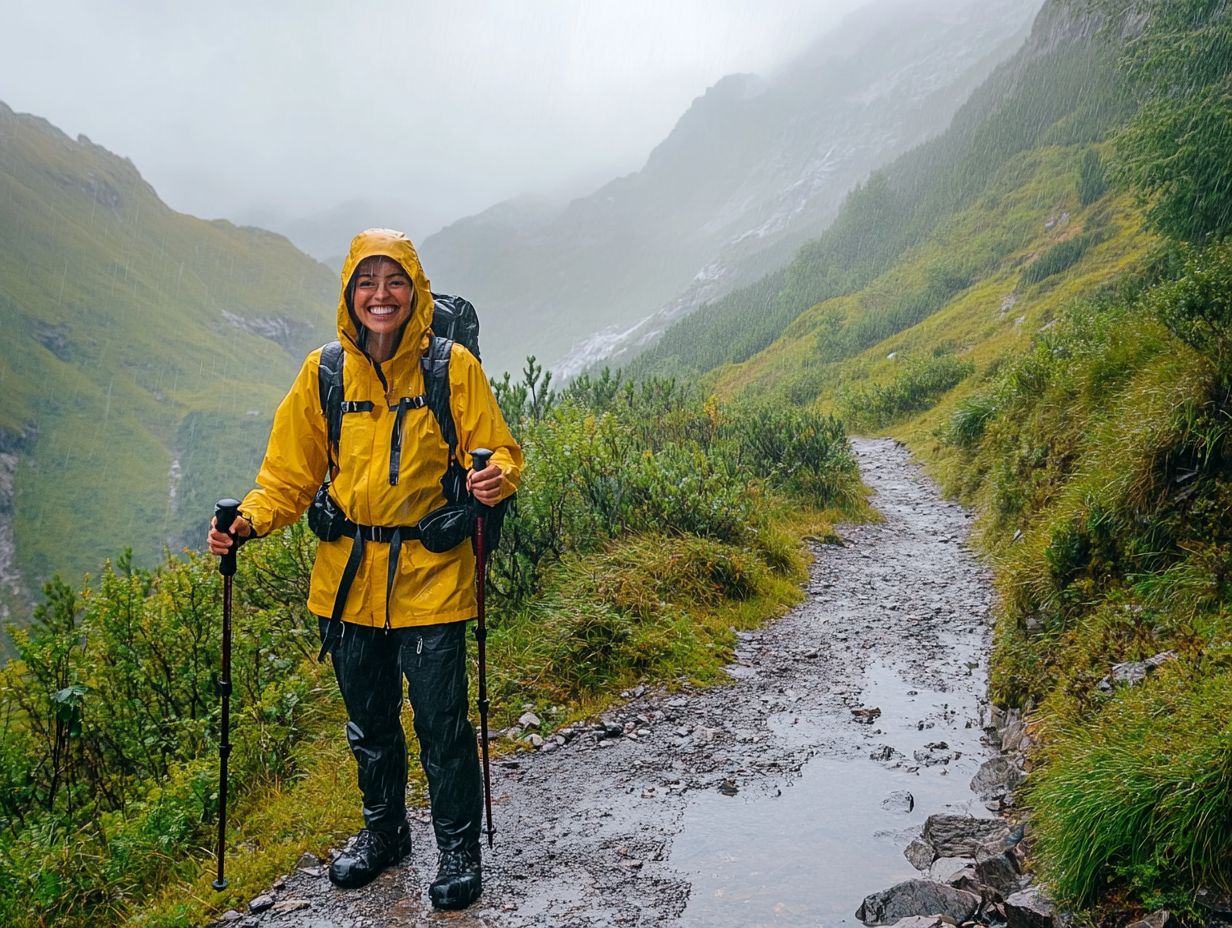
- Invest in waterproof or water-resistant outdoor clothing.
- Maintain your gear with regular cleaning and reproofing.
- Prepare for unexpected wet weather with backup clothing and emergency plans.
The Importance of Staying Dry in Outdoor Clothing
Staying dry in outdoor clothing is essential for anyone engaged in backpacking or other outdoor pursuits. Wet clothing can lead to discomfort, extreme cold, and a noticeable dip in performance.
By investing in effective moisture management the methods used to keep sweat and rain away from your skin through quality rain gear, such as a well-crafted rain jacket and waterproof pants, you can maintain comfort. This allows you to fully immerse yourself in the adventure, free from the nagging anxiety of getting soaked.
Selecting the right materials and mastering the art of layering wearing multiple clothing layers to trap warmth and protect against the elements can profoundly elevate your outdoor experience, especially when faced with unpredictable weather.
Why is it Important?
The importance of staying dry in outdoor clothing is paramount, as it impacts your comfort, safety, and overall enjoyment during backpacking trips.
When you manage to keep dry, you ll likely notice a significant boost in your morale and energy levels. This can truly make a world of difference on a challenging trek. Imagine this: an unexpected rain shower hits. With the right gear, you can enjoy your adventure without discomfort.
Consider gear like waterproof gloves to keep your hands warm and agile, making it easier to handle your equipment. High-quality rain jackets featuring breathable fabrics are also essential; they help regulate your temperature without trapping moisture inside.
By investing in these crucial rain accessories, you ll elevate your outdoor experience. You will remain focused on the stunning beauty of nature rather than the relentless struggle to stay dry.
Common Causes of Wet Clothing
Wet clothing can arise from a myriad of causes, particularly when faced with the whims of nature during outdoor adventures like backpacking. Rain, snow, and sudden weather shifts can swiftly turn your experience into a soggy ordeal if you re not adequately equipped.
Beyond precipitation, activities such as stream crossings or unexpected spills add to the likelihood of getting drenched. Recognizing these common culprits is your first step toward effective preparation, ensuring you re armed with the right rain gear, including a dependable rain jacket and waterproof pants.
Weather Conditions and Activities
Weather conditions are pivotal for outdoor activities, significantly influencing your chances of ending up with wet clothing and the necessity for suitable rain gear.
Unexpected rain showers surprise even the most seasoned adventurers, leaving you with damp clothes and discomfort. On the flip side, heavy snowfall can transform a sunny outing into a chilly wonderland, with trails hidden beneath a pristine blanket of white.
For anyone embarking on outdoor excursions, the importance of waterproof footwear cannot be overstated; it s your best defense against soggy feet, ensuring comfort no matter what lies beneath. When braving the cold, layering becomes essential to trap heat and maintain warmth, especially when wind and wet conditions team up to chill you to the bone.
Grasping these elements can tremendously elevate your outdoor experiences, making each adventure not just bearable, but truly enjoyable.
Choosing the Right Outdoor Clothing
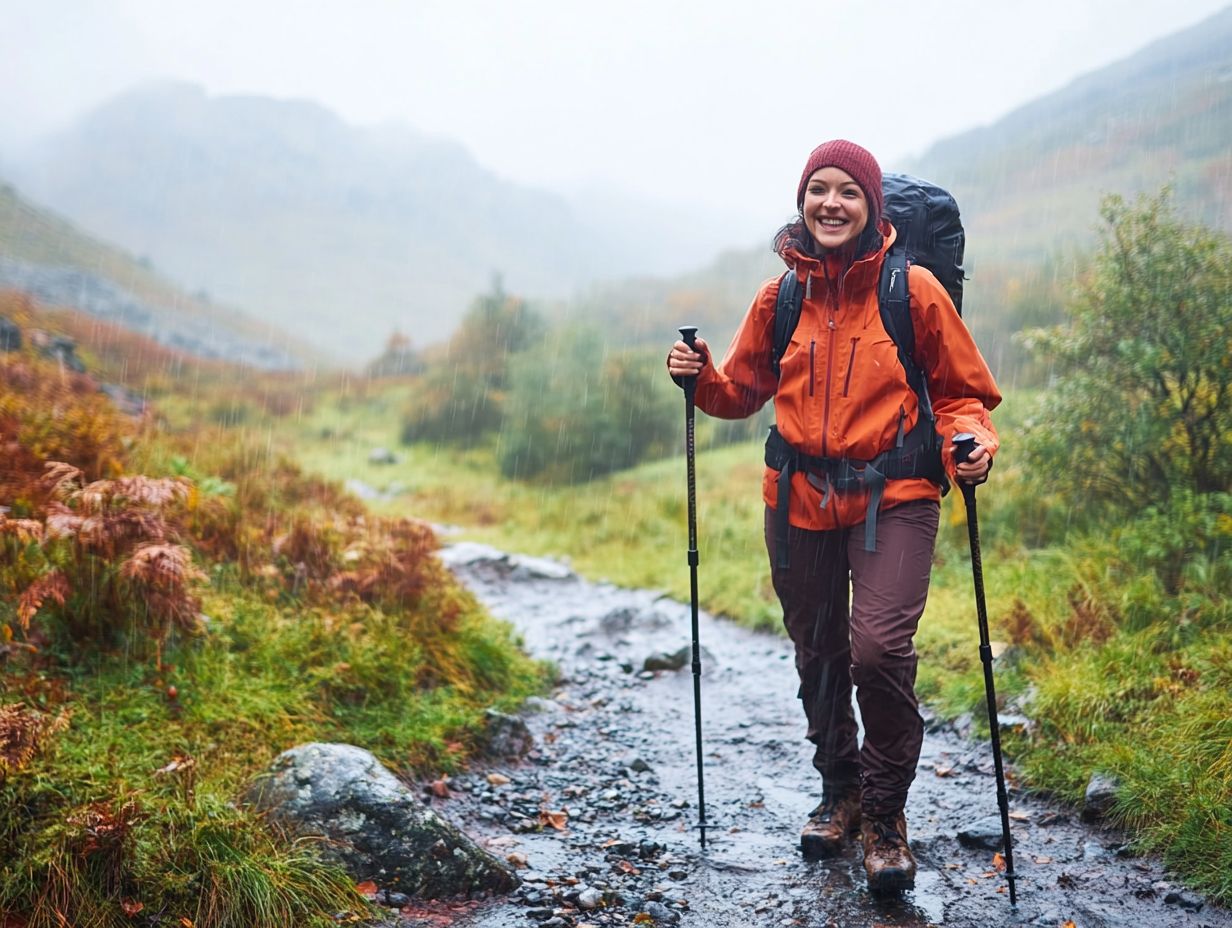
Selecting the right outdoor clothing is crucial for maintaining dryness and comfort, especially during activities like backpacking.
Opting for high-quality materials, such as Gore-Tex a material known for its waterproof properties for jackets and quick-drying clothing, can greatly enhance your ability to manage moisture effectively.
By understanding the essential features of outdoor apparel, you can elevate your experience, ensuring you re fully prepared to tackle whatever weather conditions may come your way.
Materials and Features to Look For
When selecting outdoor clothing, consider both the materials and features that will ensure effective moisture management and comfort during your adventures.
For instance, choosing synthetic fabrics that wick moisture away from your body can transform your experience. These materials keep your skin dry and help regulate your temperature.
Features like adjustable cuffs prevent wind and debris from sneaking in at the sleeves. Proper ventilation openings that allow air to flow promotes airflow, enhancing temperature control.
Together, these elements not only help you stay dry but also elevate your outdoor experience, allowing for longer and more enjoyable treks.
Proper Care and Maintenance for Outdoor Clothing
Regularly taking care of your outdoor clothing is essential for ensuring both longevity and effectiveness, especially for vital gear like rain jackets and waterproof pants.
Practices such as washing with appropriate detergents and reapplying waterproof coatings can significantly enhance the lifespan of your equipment.
Using quick-dry towels after unexpected downpours can also make a remarkable difference in managing moisture.
Tips for Keeping Clothing Dry
Keeping your clothing dry during outdoor activities hinges on a blend of smart gear choices and effective techniques.
As an outdoor enthusiast, invest in high-quality rain covers for your backpack. These provide a vital barrier against unexpected downpours.
Utilizing dry bags for your clothing protects against moisture and keeps your gear organized.
Choose your campsite wisely; selecting elevated ground and avoiding overly damp areas can significantly reduce moisture exposure overnight.
Combining these practices creates a robust moisture management system, allowing you to remain comfortable and fully immersed in nature.
Additional Strategies for Staying Dry
Finding additional ways to stay dry can improve your outdoor experience, minimizing discomfort linked to wet clothing while backpacking.
Accessories and Techniques
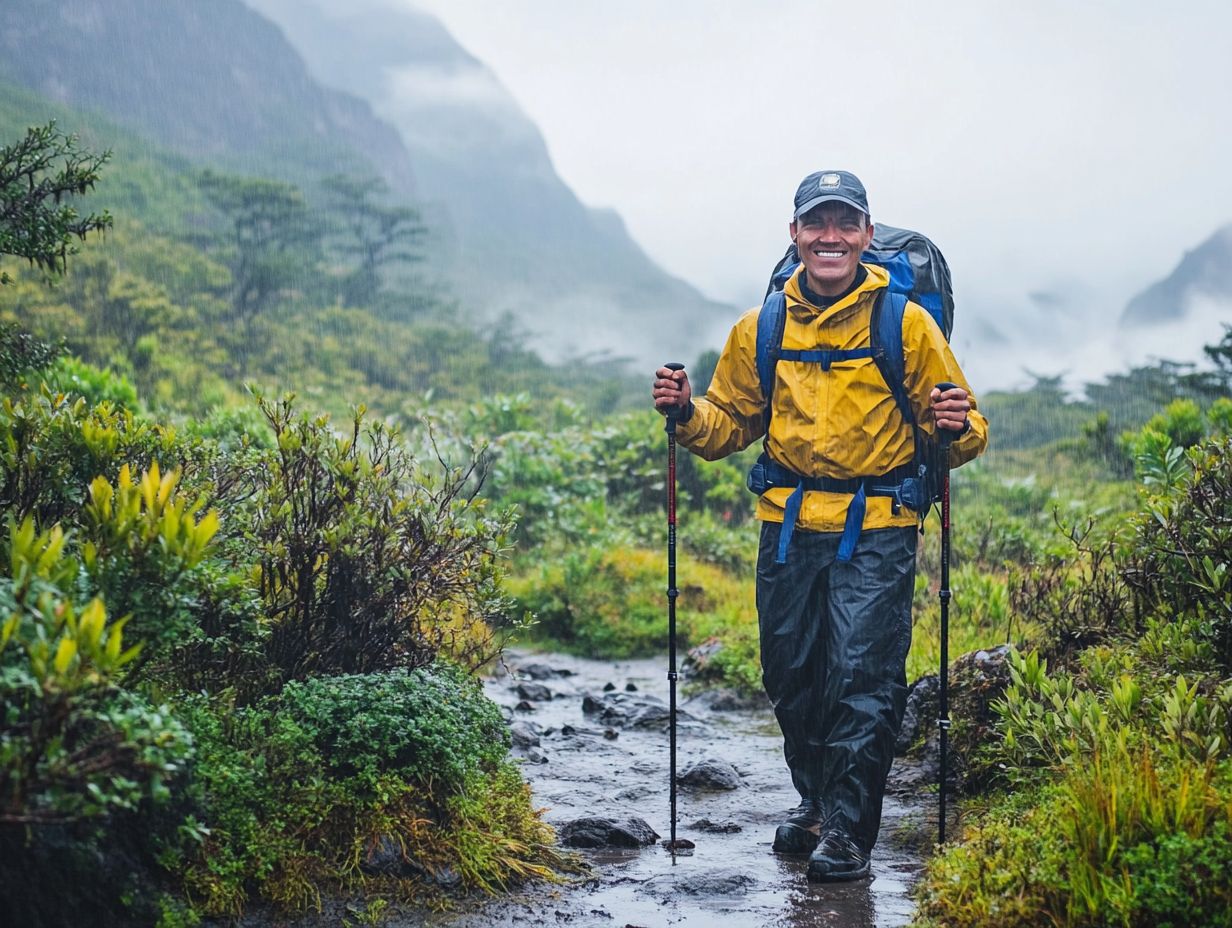
Utilizing effective accessories and techniques is essential for maintaining dryness during your outdoor adventures, especially when the weather decides to play tricks on you.
Waterproof footwear is your first line of defense against soggy trails and unexpected rain showers. When paired with quick-dry towels, these essentials enhance moisture management.
Mastering layering techniques is equally crucial; a breathable base layer wicks moisture away from your skin, while an insulated mid-layer wraps you in warmth. Completing your ensemble with an outer shell that repels water keeps you dry as you embrace the great outdoors.
Get Ready for Wet Weather
Preparing for wet weather can change your adventure in an instant, especially for outdoor enthusiasts embarking on activities like backpacking, where unexpected rain can strike at any moment.
Establishing an emergency plan with backup clothing options, like quick-dry attire, ensures you re equipped to handle whatever the weather throws your way.
Packing reliable rain gear protects you from exposure and enhances your overall experience, allowing you to enjoy your adventure despite the elements.
Emergency Plans and Backup Clothing
Robust emergency plans and backup clothing are essential for staying dry during unexpected wet weather while backpacking.
Effective emergency plans require a clear plan for quickly addressing any inclement weather that might catch you off guard. Waterproof pants and breathable rain jackets are vital components of a backup clothing system, providing crucial protection against sudden downpours.
Pair these with regular maintenance checks, like seam sealing where you seal the stitches of a jacket to prevent water from leaking through and fabric treatments to enhance your comfort and safety in the great outdoors.
Being well-prepared with the right clothing and a comprehensive emergency strategy, including quick-dry clothing and a pack cover, ensures your adventure remains enjoyable, no matter what nature throws your way.
Frequently Asked Questions
What are some tips for staying dry in outdoor clothing?
- Choose fabrics that are moisture-wicking and quick-drying, such as polyester or Smartwool, to keep you dry even when you’re sweating.
- Layer your clothing, starting with a base layer that wicks moisture away from your skin, followed by insulating layers and a waterproof outer layer.
- Ensure your outer layer is breathable, allowing moisture to escape while keeping rain and snow out.
How can I ensure my feet stay dry while wearing outdoor clothing?
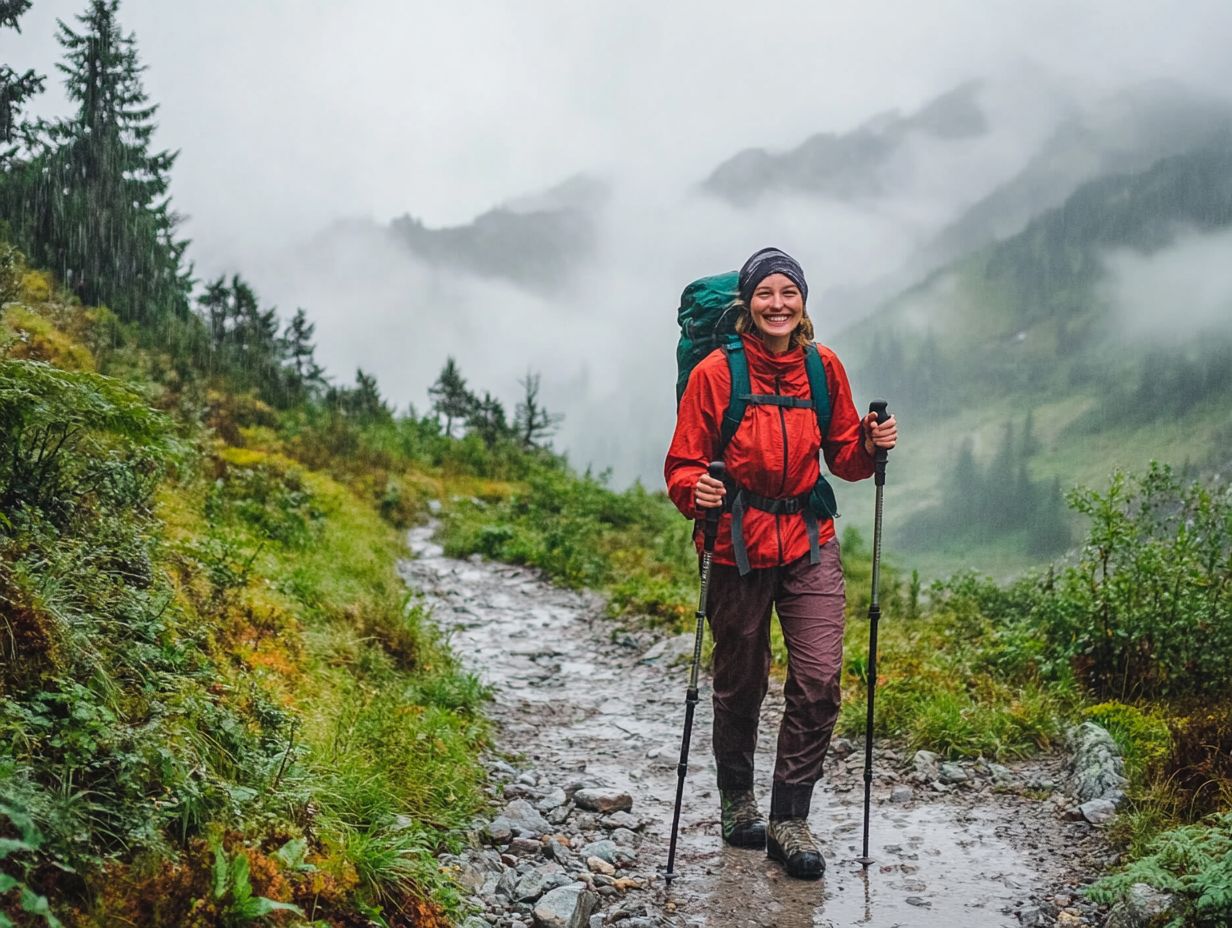
- Wear waterproof hiking boots or shoes designed for outdoor activities. Avoid cotton socks as they retain moisture and can lead to blisters.
- Consider wearing gaiters to keep rain or snow from getting into your boots, especially if you re hiking in Papua New Guinea or similar wet locations.
- Bring extra pairs of socks, such as those made from Merrell or Salomon, and change them if they become wet.
Are there any specific clothing items I should bring to stay dry in outdoor conditions?
- A waterproof jacket or raincoat, such as the Hi-Vis Rain Jacket, is a must-have for staying dry in wet weather.
- Pack a waterproof hat, gloves, and pants, along with synthetic clothing to protect your head, hands, and legs from rain and snow.
- Don’t forget a waterproof or water-resistant backpack cover to protect your belongings, especially if you’re using items like a Tarptent Double Rainbow or a Black Diamond Megalite 4P tent for outdoor activities.
Is there anything I can do to maintain the waterproofing of my outdoor clothing?
- Follow the care instructions for your clothing, including using a gentle detergent and avoiding fabric softeners.
- Re-apply waterproofing treatments, such as Nikwax or Polartec NeoShell, to your outer layers periodically for maximum effectiveness.
- Store your outdoor clothing in a dry, ventilated area to prevent mold and mildew growth.
What should I do if I accidentally get my outdoor clothing wet?
- Change into dry clothing as soon as possible to prevent hypothermia. Consider using a quick-dry towel for faster drying.
- If you’re in a survival situation, use your body heat to dry out your clothing by wearing them or placing them next to your skin while sheltering under a well-managed campfire setup.
- Hang your wet clothing up to air-dry, preferably using a Garbage Bag to protect them from the elements while avoiding direct sunlight, which can damage some fabrics.
Want to Stay Dry in Outdoor Clothing? Check These Tips!
1. Always check the weather before you head out. Be ready for sudden changes in conditions!
2. Wear a brimmed hat to shield your face from rain or snow.
3. Pack an extra set of clothes, including a durable jacket like the Arcteryx Beta SV, which is perfect for wet conditions.

